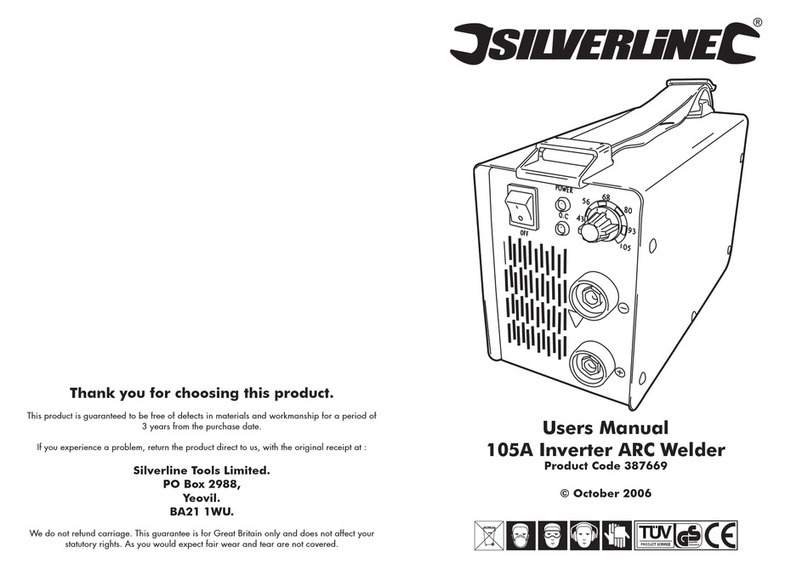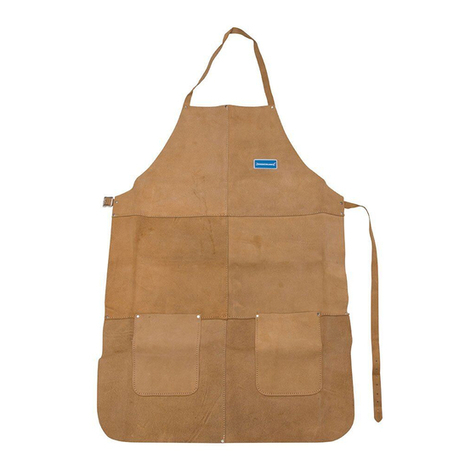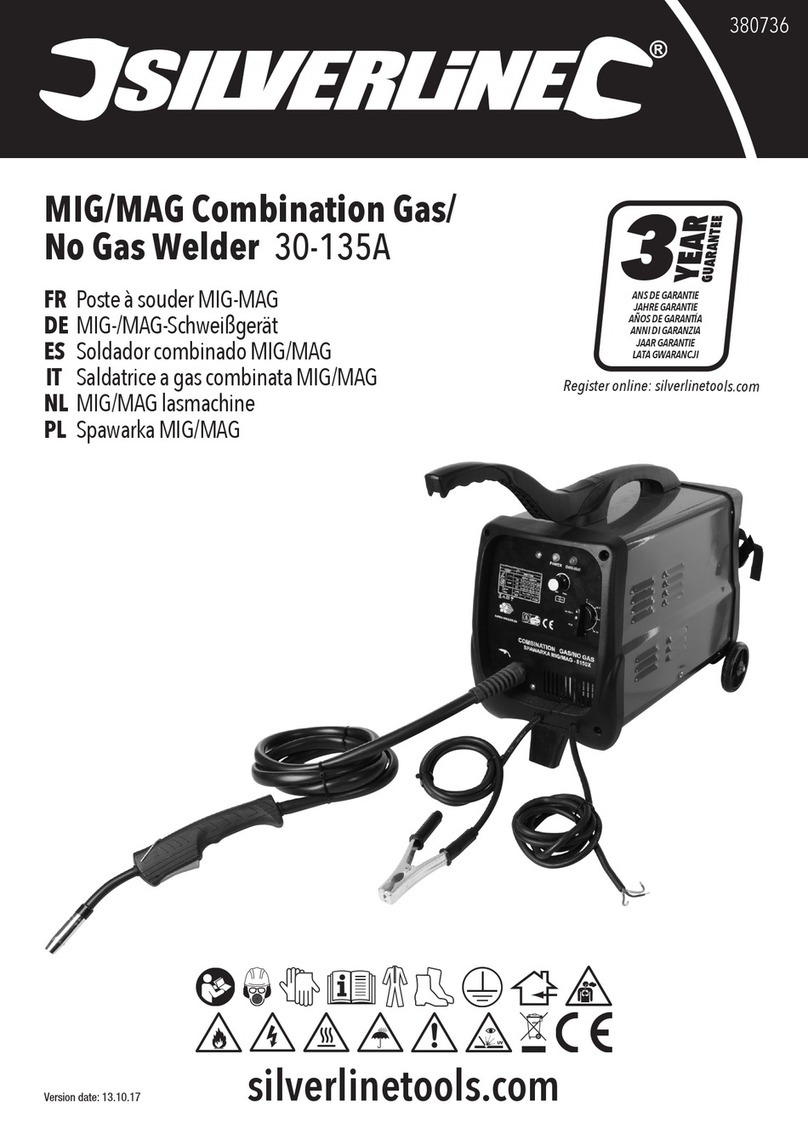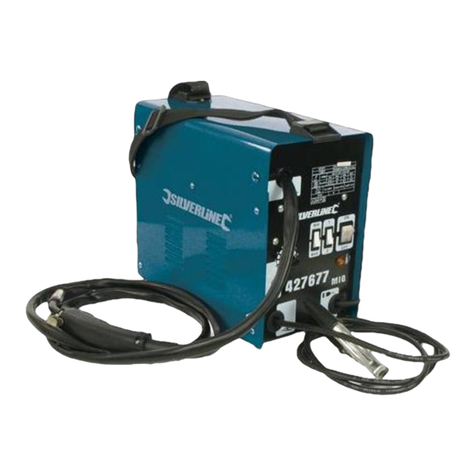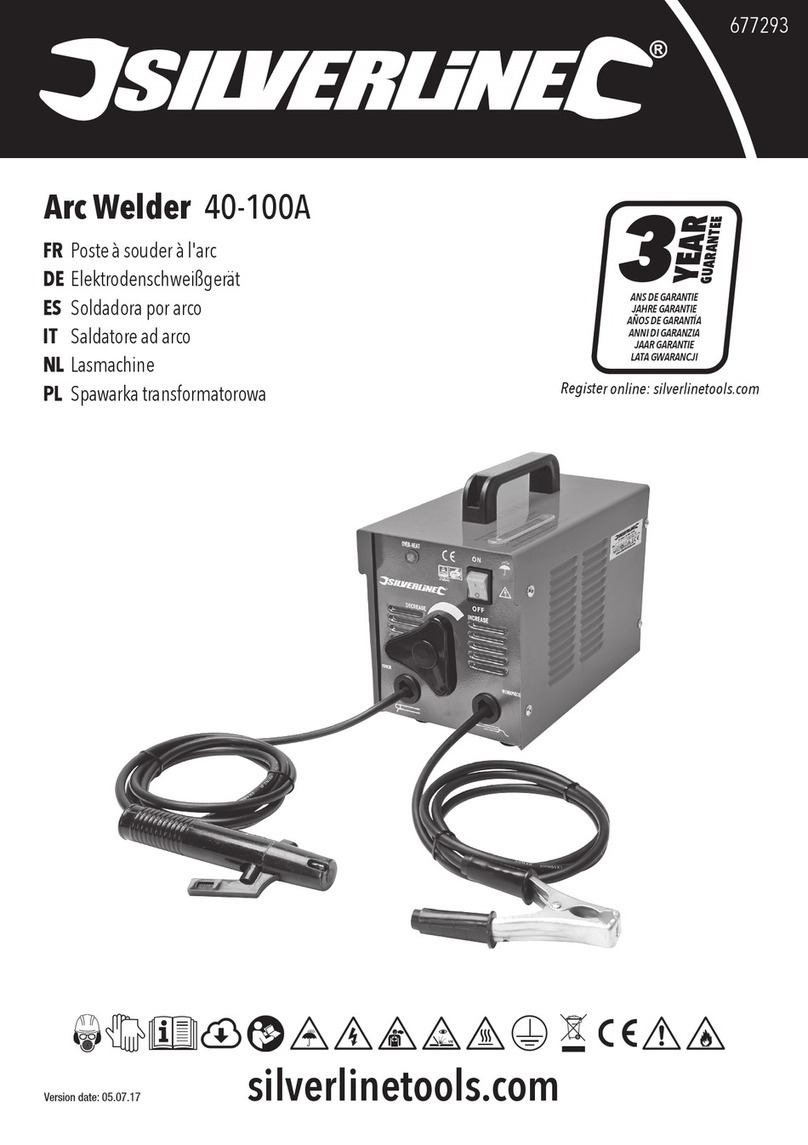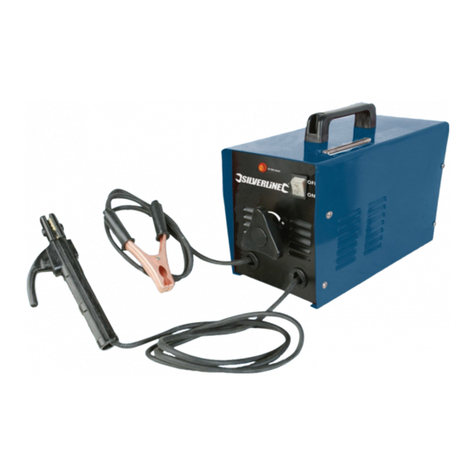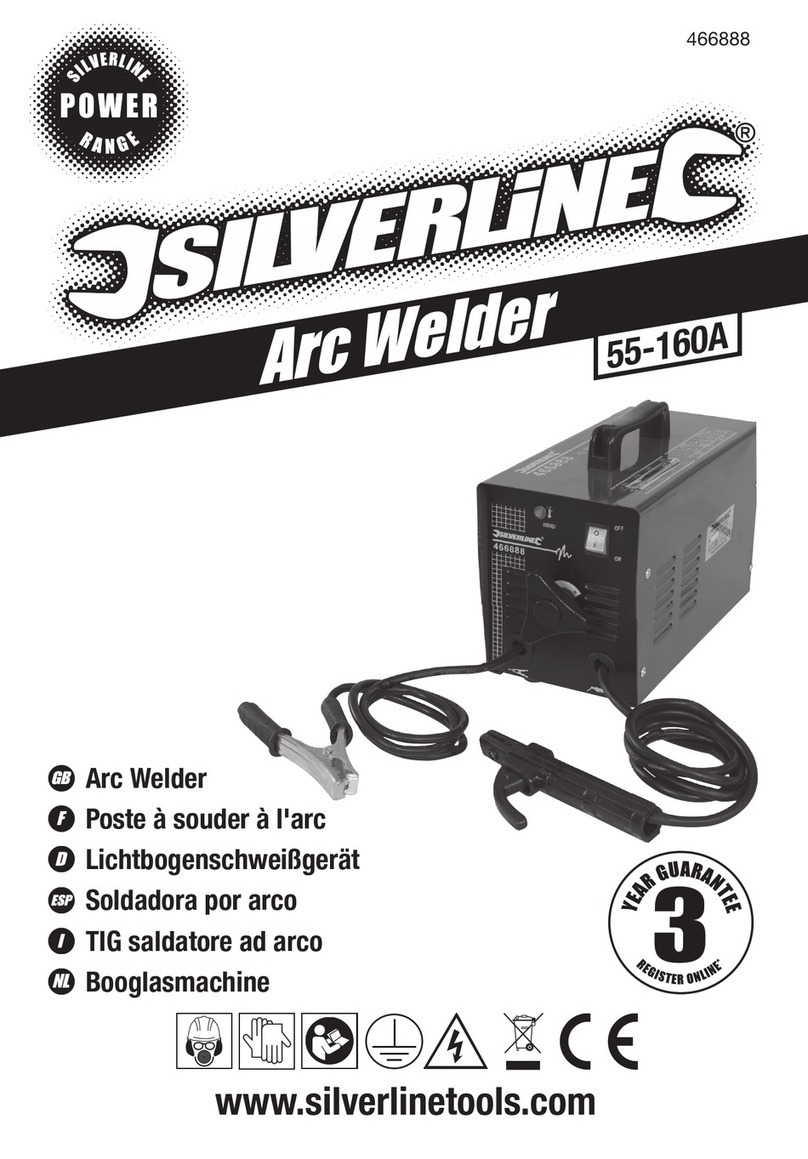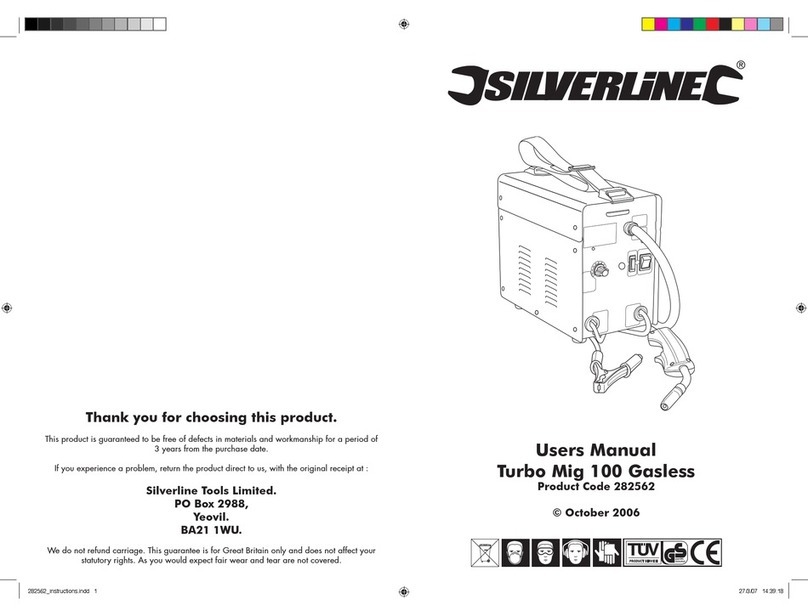1. Temperature indicator
2. On/off switch
3. Magnetic shunt
4. Earth clamp
5. Electrode holder
6. Handle
7. Graduated welding amperage scale
SPECIFICATION
Voltage 230V
Frequency 50Hz
No load voltage 48V
Current range 55-160A
Input capacity 6.5kW
ADDITIONAL SAFETY INSTRUCTIONS
Do not operate the welder in a confined space.
The welder is required to operate in a good air space to aid
cooling.
Keep work area clean and provide the correct working
conditions.
•Arc welding produces sparks and high temperature fused
metal projectiles and fumes.
• Remove all flammable substances and materials from the
work surface.
• Provide adequate ventilation of facilities where welding
takes place.
• Do not weld on containers or pipes that hold or have held
flammable liquid or gaseous combustibles or on materials
cleaned with chlorinated solvents or on varnished surfaces.
•Cluttered areas invite injuries. Make sure the area is clear of
obstacles, which could cause accidents.
Always wear protective equipment.
Personal protective clothing must be worn, use adequate
electrical insulation with regard to the electrode, the work
piece and any earthed metal parts in the vicinity. This is
achieved by wearing gloves, shoes, head coverings (such as
the face mask provided) and clothing designed for this
purpose and using insulating platforms and mats.
Rated duty cycle 10%
Class of insulation H
Electrode size range 2-4.0mm
Fuse 16A
Mains plug Earthed
•Before carrying out maintenance on the welder ensure that
it is disconnected from the power supply.
• You must ensure that a qualified person carries out repairs
and maintenance of electrical opponents.
• When the welder is not in use, turn it off at the mains. Live
electrodes present a hazard, as they can arc against the
earthed metal.
•Before using the welder, check every time that the cable
connections are fully tightened and that there are no broken
parts.
• Keep welding cables, the electrode holder and the earth
clamp in good condition. Poor contact through the welding
circuit caused by defective cables and clamps can be
dangerous and produces poor fields.
Introduction
Carefully read and understand this manual and any label
attached to the tool before use. Keep these instructions with the
product for future reference. Ensure all persons who use and
service this product are acquainted with this manual.
Electrical Safety Information
• The wires in this product are coloured:
Blue Neutral (N)
Brown Live (L)
Green & Yellow Earth (E)
• As the colours may not correspond with the coloured markings
identifying the terminals in your plug, proceed as follows.
• The wire which is coloured blue must be connected to the
terminal which is marked with the letter N or coloured black, the
wire which is coloured brown must be connected to the terminal
which is marked L or coloured red.
• This appliance must be protected by a suitable fuse.
• To prevent fire or shock hazard, do not expose this product to
rain/water or moisture. There are no user serviceable parts
inside except those referred to in this manual. Always refer
servicing to qualified service personnel. Never remove any part
of the casing unless qualified to do so; this unit contains
dangerous voltages.
• Use of a residual current device (RCD) will reduce the risk of
electric shock.
NEVER CONNECT THE BROWN OR BLUE WIRE TO THE
EARTH PIN OF THE 13 AMP PLUG. IF IN DOUBT CONSULT A
QUALIFIED ELECTRICIAN
General Safety Instructions
Even when used as prescribed it is not possible to eliminate all
residual risk factors. Use with caution.
Keep guards in position
•Always keep guards in position, in good working order, correctly
adjusted and aligned. Never attempt to use a power tool
without any guard supplied with it.
Remove adjusting keys
• Always check to see that keys and adjusting wrenches are
removed from power tool before turning on.
Clean work area
•Accidents occur where benches and work areas are cluttered or
dirty, floors must be kept clear, avoid working where the floor is
slippery.
Dangerous environment
• Do not use power tools in damp or wet conditions, or expose
them to rain. Provide adequate surrounding work space and
keep area well lit. Do not use power tools where there is a risk
of explosion or fire from combustible material, flammable
liquids, flammable gases or dust of an explosive nature. When
using power tools avoid contact with any earthed items such as
pipes, radiators, cookers, refrigerators, metal baths and taps.
Children & Pets
• Children and pets should always be kept at a safe distance
from your work. Make your workshop child-proof. Lock tool
away where children can't get access to them. Remove
batteries from cordless tools.
Use the correct power tool
•Don't force, or attempt to use a power tool for a purpose it was
not designed for. Do not use a small tool to do the job of a
heavy duty tool.
Wear correct clothing and footwear.
• Don't wear loose clothing, neckties or jewellery or other items
which may get caught in moving parts. Wear non-slip footwear,
cover or tie back long hair. Use safety footwear if necessary.
Protect your head
• Wear safety goggles at all times, every day glasses are not
sufficient for eye protection, as lenses are not impact resistant
and could shatter. Use an approved face or dust mask when
operation creates dust. Ensure dust extraction equipment is
functioning and correctly used. Hearing protection should be
used if the sound intensity level for the operator could exceed
85dB(A). Use a hard hat where there is a risk of falling objects
or striking your head on low level obstructions.
Protect yourself from vibration.
• Hand held power tools may produce vibration. Vibration can
cause disease. Gloves to keep the operator warm and dry and
therefore maintain good blood circulation in the fingers may
help. This tool has not been designed for extended or industrial
operation.
Secure work
• Always secure work. Where practical use a clamp or vice, it will
allow you to use both hands to operate your power tool.
Keep your balance
• Don't over reach, keep proper footing at all times to ensure
correct balance.
Maintain your power tool
• Keep your power tool in good working order, keep tools sharp
and clean for best and safest performance. Ensure ventilation
holes are kept clean and unrestricted at all times.
Always disconnect.
• Before changing tools, always ensure they are disconnected
from the power source.
Accessories
• The use of any attachment or accessory other than those
mentioned in this manual could result in damage or injury. The
use of improper accessories could be dangerous.
Never stand on your power tool
• Standing on your power tool or its stand could cause serious
injury if the tool is tipped or if the cutting tool is accidentally
contacted. Do not store materials above or near the tool so that
it is necessary to stand on the tool or its stand to reach them.
Switch off before connecting.
•Ensure the power tool is switched off before connecting to the
power source.If the power tool stops unexpectedly turn the
power switch to off.
Do not abuse the power cord.
•Be sure your cable/extension cable is properly wired and in
good condition. Always replace a damaged cable/extension
cable or have it repaired by a qualified person before using it.
Never yank or pull the cable to disconnect it from the power
socket. Never carry your power tool by it’s cable. Keep the
cable away from damp, heat, oil, solvents, and sharp edges.
Check for damaged or missing parts.
• Before each use check if any part of the power tool is damaged
or missing, check carefully that it will operate properly and
perform its intended function. Check alignment of moving parts
for binding. Any guard or other part that is damaged should be
correctly repaired or replaced. Do not use if the power switch
does not turn the power on and off. Check any other condition
that may affect the safety of the power tool. DO NOT USE IF
DEFECTIVE.
Direction of feed
•Feed work into a blade or cutter against the direction of rotation
of the blade or cutter only.
Don't leave the tool running unattended
• Always wait until your power tool has come to a complete stop
before leaving it and then disconnect from power source.
Product Familiarisation
Arc Welder
5
2
3
1
67
4

